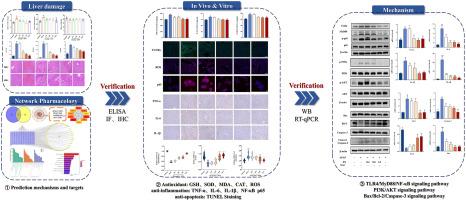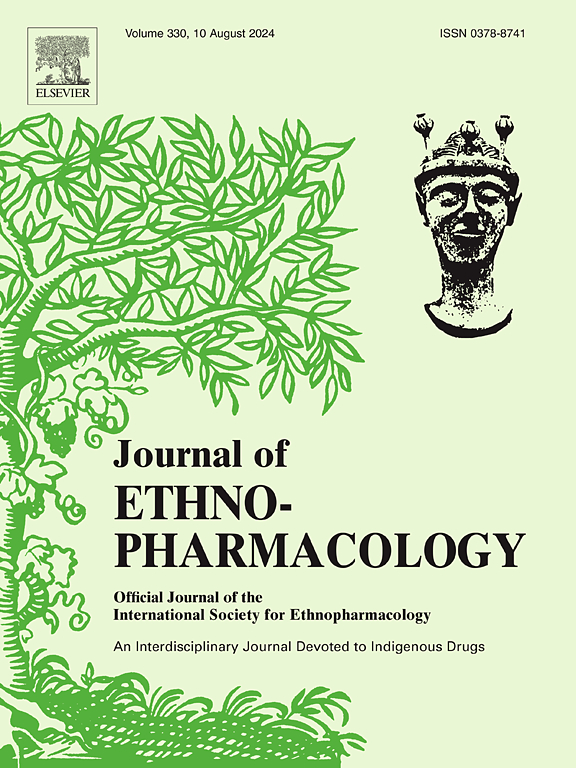Shilajit提取物(ZhaXun)通过调节NF-κB/AKT/Caspase-3轴对对乙酰氨基酚诱导的肝损伤具有保护作用。
IF 5.4
2区 医学
Q1 CHEMISTRY, MEDICINAL
引用次数: 0
摘要
最近的研究表明,ZX中的生物活性成分,如腐植酸、黄腐酸和异鼠李素,具有抗炎、抗氧化和免疫调节活性。这些特性表明其在减轻对乙酰氨基酚(APAP)诱导的急性肝损伤(ALI)方面具有潜在的治疗相关性。研究目的:本研究旨在探讨ZX对apap诱导的ALI的肝保护作用。材料与方法:筛选ZX治疗ALI的潜在靶点,构建蛋白-蛋白相互作用(PPI)网络。使用Cytoscape软件确定核心靶点,然后进行GO和KEGG分析。通过评价氧化应激、炎症和凋亡来观察ZX对apap刺激的HepG2细胞和小鼠的影响。通过免疫组织化学(IHC)、免疫荧光(IF)、逆转录定量聚合酶链反应(RT-qPCR)和免疫印迹(WB)等方法验证了ZX抗ALI的潜在机制。结果:ZX预处理剂量为0.4、0.8、1.6 g/kg(灌胃给药),可有效减轻apap诱导的肝损伤(300 mg/kg),血浆ALT和AST水平分别下降75.0%和69.8%。网络药理学分析预测ZX通过调节氧化应激、炎症反应和凋亡通路,对apap诱导的ALI具有全面的保护作用。结果表明,ZX不仅可以通过调节氧化应激标志物(SOD、MDA、CAT、GSH)改善apap诱导的肝脏氧化损伤,还可以通过抑制相关炎症因子(TNF-α、IL-6、IL-1β)的水平减轻肝脏炎症。TUNEL染色法定量观察肝细胞凋亡情况。最后,WB和RT-qPCR结果进一步验证了ZX通过PI3K/AKT和TLR4/NF-κB通路减弱apap诱导的肝脏炎症。ZX通过平衡Bax/Bcl-2表达和降低Caspase-3激活抑制肝细胞凋亡。结论:ZX通过减轻炎症反应和肝细胞凋亡来减轻apap诱导的ALI。体内和体外实验均表明,ZX可通过NF-κB/AKT/Caspase-3通路减轻apap诱导的ALI。本文章由计算机程序翻译,如有差异,请以英文原文为准。

Shilajit extract (ZhaXun) protects against acetaminophen-induced liver injury via modulation of the NF-κB/AKT/Caspase-3 axis
Ethnopharmacological relevance
Shilajit, a natural product utilized in traditional Tibetan medicine and known in China as ZhaXun (ZX), has been historically used for treating liver disorders. Recent studies have indicated that bioactive components in ZX, such as humic acid, fulvic acid, and isorhamnetin, exhibit anti-inflammatory, antioxidant, and immunomodulatory activities. These properties suggest its potential therapeutic relevance in alleviating acetaminophen (APAP)-induced acute liver injury (ALI).
Aim of the study
This study aims to investigate the hepatoprotective effects of ZX against APAP-induced ALI.
Materials and methods
The potential targets of ZX for ALI treatment were screened and then used to construct the protein-protein interaction (PPI) network. Core targets were identified using Cytoscape software, followed by GO and KEGG analyses. The effects of ZX on APAP-stimulated HepG2 cells and mice were determined by evaluating oxidative stress, inflammation and apoptosis. The potential mechanisms of ZX against ALI were verified by immunohistochemistry (IHC), immunofluorescence (IF), Reverse Transcription Quantitative Polymerase Chain Reaction (RT-qPCR) and Western blotting (WB) methods.
Results
Pretreatment with ZX at doses of 0.4, 0.8, 1.6 g/kg (administration by gavage) effectively attenuated APAP-induced liver injury (300 mg/kg), as confirmed by a decrease in plasma ALT and AST levels (75.0 % and 69.8 %, respectively). Network pharmacology analysis predicted ZX exerts a comprehensive protective effect against APAP-induced ALI by regulating oxidative stress, inflammatory response and apoptotic pathways. The results suggested that ZX not only ameliorated APAP-induced liver oxidative damage by regulating oxidative stress markers (SOD, MDA, CAT, GSH), but also diminished liver inflammation by inhibiting the levels of related inflammatory factors (TNF-α, IL-6, IL-1β). In addition, hepatocyte apoptosis was quantified by TUNEL staining. Finally, WB and RT-qPCR results further verified that ZX attenuated APAP-induced liver inflammation through PI3K/AKT and TLR4/NF-κB pathways. ZX inhibited hepatocyte apoptosis by balancing Bax/Bcl-2 expression and reducing Caspase-3 activation.
Conclusion
ZX alleviates APAP-induced ALI by attenuating inflammatory response and hepatocyte apoptosis. Both in vivo and in vitro experiments have demonstrated that ZX alleviates APAP-induced ALI through NF-κB/AKT/Caspase-3 pathways.
求助全文
通过发布文献求助,成功后即可免费获取论文全文。
去求助
来源期刊

Journal of ethnopharmacology
医学-全科医学与补充医学
CiteScore
10.30
自引率
5.60%
发文量
967
审稿时长
77 days
期刊介绍:
The Journal of Ethnopharmacology is dedicated to the exchange of information and understandings about people''s use of plants, fungi, animals, microorganisms and minerals and their biological and pharmacological effects based on the principles established through international conventions. Early people confronted with illness and disease, discovered a wealth of useful therapeutic agents in the plant and animal kingdoms. The empirical knowledge of these medicinal substances and their toxic potential was passed on by oral tradition and sometimes recorded in herbals and other texts on materia medica. Many valuable drugs of today (e.g., atropine, ephedrine, tubocurarine, digoxin, reserpine) came into use through the study of indigenous remedies. Chemists continue to use plant-derived drugs (e.g., morphine, taxol, physostigmine, quinidine, emetine) as prototypes in their attempts to develop more effective and less toxic medicinals.
 求助内容:
求助内容: 应助结果提醒方式:
应助结果提醒方式:


